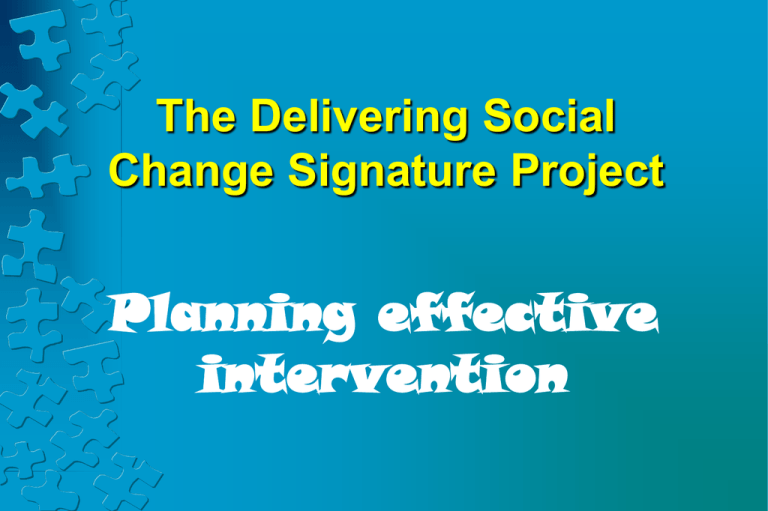selected students
advertisement

The Delivering Social Change Signature Project Planning effective intervention Objectives: • To highlight strategic planning as a crucial factor underpinning the success of the Signature Project. • To suggest a planning framework. • To develop teachers’ awareness of a range of factors that inform effective intervention. • To communicate a range of intervention strategies. Worst case scenario… Rationale ‘Why are we doing this?’ Belief in the project is crucial. The absence of a positive attitude to the work will undermine the success of the project. This is true of the leaders (the Heads of Department, senior management, the principal, the board of governors), the teachers and the students. A positive attitude to the project does not arrive in an envelope with the Signature teacher. It has to be nurtured. This requires effective leadership. We affect each other’s attitudes! Excuses, interruptions, slow pace, lack of knowledge about the project, the perception that one teacher is acting in a vacuum, the absence of willingness to accept the role of leader…these elements are hugely damaging. Just do it! Change often starts with just one person. As Head of Department, I held a passionate belief in the objectives of the Signature Project, the potential for real social change and the importance of GCSE English and Mathematics as essential qualifications for our students. This was, in part, a product of experiencing the success of intervention strategies from 2012-2013 and the impact on tangible results: moving from 33.8% to 60.2% A*-C in GCSE English. Change will not come if we wait for some other person, or if we wait for some other time. We are the ones we’ve been waiting for. We are the change that we seek. - Barack Obama Education is the most powerful weapon which you can use to change the world. - Nelson Mandela Or… Weasling out of things is important to learn. It’s what separates us from the animals…except the weasel. - Homer Simpson Getting started... The board of governors, principal, senior management and Head of Department will: - decide on focused support for English or Mathematics or shared support (in view of the school development plan and departmental results). - organise the interview procedure, short list candidates, use the Signature Project funding to appoint a new teacher. - decide whether the seconded teacher or the new appointment will provide targeted support for GCSE students. Getting started... The board of governors, principal, senior management and Head of Department will: - develop a shared vision of the importance of effective intervention to ensure that students achieve their potential in GCSE English Language and GCSE Mathematics. - make links between intervention programmes, for example, the principles informing the SBALC action plan and the Signature project. Who? A leadership model for the Head of Department What? Really? How? Now what? A leadership model The Head of Department will: - plan departmental meetings to launch guidelines for the department’s involvement in the Signature Project. - ensure that the teachers in the department are informed about the objectives of the Signature Project, with emphasis on measurable improvement in GCSE results. What? A leadership model What? The Head of Department will: - lead the teachers in the department in the development of a shared vision for the Signature Project. - involve the whole department in planning, monitoring and review. A leadership model What? The Head of Department will: - take account of the aptitudes of the teachers in the department to allocate specific roles – not just the Signature Project teacher but all Year 11 and 12 teachers will provide targeted support for selected students - plan the Signature teacher’s timetable, for example, to establish a balance between English and Mathematics; to facilitate sustained support or rotational support. A leadership model What? The Head of Department will: - involve the whole department in the selection of students. - lead each teacher to take account of the needs of the children in the school. Selection of students What? The Head of Department will ensure that the selection process: - is careful and thorough - begins when students are in Year 10 (for example, Assessment 3 results) - reflects the effective use of data (for example, Progress in English results, Yellis test results, results of examinations, controlled assessment results, predicted Grades). Selection of students What? The Head of Department will ensure that the selection process: - reflects each teacher in the department’s knowledge of individual students - is not confirmed until the Signature teacher has had opportunities to observe the selected students in the whole class context. Selection of students What? • Teachers’ relationships with students is an important factor in the selection process. • Often, students’ relationship with the specific teacher was a deciding factor in establishing those students who remain in class and those who are withdrawn for support. Selection of students Really? The Head of Department will ask the teachers in the department, ‘Have we selected the appropriate students?’ - review the selection of students - ask the Signature teacher to reflect on her observation of the selected students in the whole class context before final decisions are confirmed - review the selection process, ‘Do these students have realistic potential to achieve Grade C with teacher support?’ ‘Do the selected students need support? The Head of Department will: Really? - value the feedback of teachers who have forged excellent relationships with students. - invite feedback from individual teachers in relation to the allocated roles, ‘I think my strength lies in…’ ‘Paula and I can work together to…’ - review the decision making process, ‘Does it take account of the needs of the children in the school?’ Decisions must be based on data and informed knowledge of students; decisions must not be arbitrary. The Head of Department will: - plan the Signature teacher’s timetable: will the Signature teacher give support to GCSE English students or GCSE Mathematics students or students in both subjects? - consider the appropriate balance if subject needs are to be shared - allocate at least five planning and preparation periods to the Signature teacher’s timetable The Head of Department will: - review the Signature teacher’s timetable, for example, which students require sustained support and which students just require rotational support. - plan departmental meetings to review the selection process The Head of Department will: - invite teachers’ feedback – an environment of trust is crucial here. - review data, for example, controlled assessment performance, practice paper results. - invite students’ feedback. - take steps as a result of the review process. Now what? Who? The teachers in the department What? Really? How? Now what? The Groundwork: Allocating Teachers’ Roles Who? Identifying the Signature teacher Which teacher will deliver the Signature Project – the new appointment or the seconded teacher? This teacher must be identified as the Signature teacher. This teacher must receive training and support. The Groundwork: Allocating Teachers’ Roles Who? Not just the Signature Project teacher but all Year 11 and 12 teachers will provide targeted support for selected students. Each teacher in the department must be aware of his or her role. Each teacher in the department must have clear knowledge of the students that he or she will support and agreed strategies to support these students. The Signature teacher will: - observe the selected students in the whole class context to gain information about the children’s attitude to their work, work ethic and specific areas of strength and weakness. - in view of students’ needs, set targets for the Signature project, in relation to Grades and performance in individual units and tasks. What? The Signature teacher will: - in view of students’ needs, set targets for the Signature project, in relation to Grades and performance in individual units and tasks. It is important that the Signature teacher perceives the targets as achievable, with sustained effort. The teacher needs to feel motivated! What? The Signature teacher will: Really? - reflect on the observation to inform effective selection - reflect on the observation stage to inform planning for intervention strategies The Signature teacher will: - either give support to GCSE English students or GCSE Mathematics students or students in both subjects. - provide sustained support for a small group of set students or rotational support for students in a specific class. - suggested model: sustained support for at least one group of students throughout Year 11 and 12. These students will be withdrawn from the wider class on a permanent basis. In addition, rotational support for students who need some support to address specific weaknesses. The Signature teacher will: - develop secure knowledge of the requirements of each unit: examination, controlled assessment - avail of a range of resources, including the examination mark scheme, controlled assessment mark scheme, examiner’s reports, up-to-date guidance from the examination board, moderator’s reports - plan effective teaching strategies, for example, focus on specific questions in the examination The Signature teacher will: - examine students’ timetables to allocate additional support. - Which students require further support? - Can students be withdrawn for other classes? for example, PR, a component which a child has completed (such as First Aid, which some students have completed outside of school). The Signature teacher will: - in consultation with the Head of Department and other teachers in the department, review the targets established for the Signature project. Now what? The Groundwork: Students • Strategic plans for the selection of students. • Selection should begin in Year 10. • Relationships with students are crucial. Rogers – three core conditions – genuineness is paramount- need to know that you care about their achievement. “I did it for you, Miss” is a wonderful thing to hear. The Groundwork: Students • Relationships with students are crucial. Carl Rogers – three ‘core conditions’ refer to the adult’s attitude to the child, of which genuineness is paramount. • Students need to know that you care about their achievement. • You won’t believe in the potential for success if you don’t have effective relationships with your students. • “I did it for you, Miss” is a wonderful thing The Groundwork: Parents • Parental support must be encouraged. • Letter for parents. • Parental involvement – how to support your child. Training provided in St Joseph’s College. Student self-assessment • The teacher cannot expect student self-assessment to be effective as a matter of course. •The teacher must provide clear structures and clear guidance for students. Example: Am I prepared to meet the requirements of the Unit 3a controlled assessment? • The teacher must first provide scaffolds to help students to understand the mark scheme. Student self-assessment • Guide students to answer the question, ‘How do I achieve Band 3/4/5?’ • Involve students in realistic but ambitious target setting. • Focus on the requirements of the targeted Band. • Examine the examiner’s language with students and guide students to understand how to demonstrate the skills required. • Students must grasp the importance of high standards not just for this qualification but for their life. To say THEMSELVES without being told, that’s not good enough, I can do better. Paragraph structure SP, PQC, PQC, CS, PQC, PQC, CP Teaching Methodologies • Active Learning strategies. • Learning intentions are drawn from the Thinking Skills and Personal Capabilities framework. • The English teacher plans activities that lead students to not just ‘look’ but ‘see.’ • These activities encourage students to think, discuss and evaluate. What is Active Learning? Active Learning is where you’re not sitting writing notes but sitting in a group discussing things. - Finn Campbell Active Learning is what you learn while you do it. You’re learning actively while you look at the work and you pick up little things. - Michael Kostek Active Learning is when you are working and finding your way of learning, participating and you’re really interested in the task set. - Christine Mc Atamney It’s the fastest and easiest way of learning. It also means sharing and getting ideas from different sources or groups. -Esther Bambidele What is Active Learning? Active Learning is, I think, working with your class, sharing your own ideas and thoughts and being active with everyone in the class. Ashley Lo Working in groups, speaking out and helping each other understand. - Conor Boyle It helps you to learn by activating parts of your brain, for example, creativity and imagination that you would otherwise not use everyday. - Shauna Breslin Active Learning is when you’re not writing as much as you would usually write in English. It is when you are being active and having fun at it but you are learning at the same time. - Courtney Wetherall Thinking, Problem-Solving & Decision-Making Managing Information Working with Others Being Creative & Thinking, Problem-Solving & Decision-Making Managing Information • • • • distinguishing fact from opinion making links between cause and effect generating possible solutions justifying methods and conclusions • asking questions • breaking down a task • evaluating information Working with Others • • • • listening sharing opinions respecting others’ views collaboration, negotiation Being Creative & • seeking out questions to explore • experimenting with ideas, e.g. green hat Self-Management • evaluating strengths and weaknesses • setting targets • managing self, e.g. time Managing Information Learning intentions Students will be able to: • ask focused questions. 5 • plan and set goals, break task into sub-tasks. 5 5 5 5 • use own and other’s ideas to locate sources of information. • select, classify, compare and evaluate information. • select most appropriate method for a task. • use a range of methods for collating, recording and representing information. 5 • communicate with a sense of audience and purpose. 5 Thinking, Problem Solving, Decision Making Learning intentions Students will be able to: • • • • • • • • sequence, order, classify, make comparisons. make predictions, examine evidence, distinguish fact from opinion. make links between cause and effect. justify methods, opinions and conclusions. generate possible solutions, try out alternative approaches, evaluate outcomes. examine options, weigh up pros and cons. use different types of questions. make connections between learning in different contexts. 5 5 5 5 5 5 5 5 Self Management Learning intentions Students will be able to: • be aware of personal strengths, limitations and interests • set personal targets and review them • manage behaviour in a range of situations • organise and plan how to go about a task • focus, sustain attention and persist with tasks. • review learning and some aspect that might be improved • learn ways to manage own time. • seek advice when necessary. • compare own approach with others and in different contexts 5 5 5 5 5 5 5 5 5 Being Creative Learning intentions Students will be able to: • seek out questions to explore and problems to solve • experiment with ideas and questions • make new connections between ideas/information. 5 5 5 5 • learn from and value other people’s ideas • make ideas real by experimenting with different designs, actions, outcomes. 5 • challenge the routine method. • value the unexpected or surprising • see opportunities in mistakes and failures • take risks for learning 5 5 5 5 Working with Others Learning intentions Students will be able to: • • • • • • • • • • listen actively and share opinions 5 develop routines of turn-taking, sharing and cooperating. 5 give and respond to feedback 5 understand how actions and words effect others 5 adapt behaviour and language to suit different people and situations 5 take personal responsibility for work with others and evaluate own contribution to the group. 5 be fair. 5 respect the views and opinions of others, reaching agreements using negotiation and compromise. 5 suggest ways of improving their approach to 5 working collaboratively 5 Assessment for Learning Give each student a handout of the TS &PC framework – naming the five strands and the specific skills and capabilities. Provide students with the learning intentions for each task so that students could self-monitor their progress. Highlight the expectation that students would selfassess their performance and that a member of the group would peer-assess their performance at the end of each task. Task: In a group, explore Anil’sproblem and investigate possible solutions This task will develop the following thinking skills and personal capabilities: Managing Information I will be able to... Self-assessment ask focused questions 5 plan and set goals and break tasks into sub-tasks 5 use own and others ideas to locate sources of information 5 Score: Peer-assessment 5 5 5 5 5 /3 5 5 5 5 5 5 5 5 5 5/4 Thinking, Problem Solving, Decision Making I will be able to... examine evidence, distinguish fact from opinion make links between cause and effect generate possible solutions, try out alternative approaches, evaluate outcomes justify methods, opinions and conclusions Score: Working with Others I will be able to... • listen actively and share opinions develop routines of taking turns, sharing and co-operating give and respond to feedback respect the views and opinions of others, reaching agreements using negotiation and compromise Score: Total: 5 5 5 5 5 5 5 5 5 5 5/4 5/11 Self-assessment: (Focus on one learning intention) Strength: ________________________________________________________________________ Weak area: ________________________________________________________________________ Peer-assessment: (Focus on one learning intention) Strength: ________________________________________________________________________ Weak area: ________________________________________________________________________ Students can achieve a Merit (3-9/11) or Distinction (10-11/11) for the task. Infusion The subject teacher, as facilitator, identifies a learning context, which enables the parallel development of students’ Thinking Skills and Personal Capabilities, and subject knowledge and understanding. In English, an appropriate learning context would be a character’s experience of a problem in a novel. CCEA explains, “The thinking skill deepens understanding of the subject concept or context and this, in turn, provides an opportunity for the instruction and practice of the skill.” http://www.nicurriculum.org.uk/docs/skills_and_capabilities/traini ng/TSPC-Guidance-KS3.pdf. Six Thinking Hats problem-solving approach • Edward de Bono invented the Six Thinking Hats as a framework for thinking. It is a problem-solving approach that encourages students to reflect on their thinking and to recognise that different modes of thinking are required in different situations. • White hat thinking identifies the facts and details of a topic • Red hat thinking looks at a topic from the point of view of emotions and feelings • Black hat thinking examines the problems associated with a topic • Yellow hat thinking focuses on the positive aspects of a topic • Green hat thinking requires creativeness, imagination and unfettered thinking about a topic • Blue hat thinking focuses on reflection, metacognition (thinking about the thinking that is required), and the need to understand the big picture. Rules for Group Work 1. 2. 3. 4. 5. 6. 7. Let everyone have a fair chance to speak Listen to each other Respect each other’s opinions Take part! Work together Let each person fulfil their role Focus on the problem Questioning techniques Using questioning techniques during the task promotes the development of students’ critical thinking skills, for example: • Acting as devil’s advocate • Asking pupils to unpack their thinking Ask pupils to defend their reasoning against different points of view. ‘Describe how you arrived at your answer’. • Encouraging pupil questioning Let pupils develop their own questions. Roles within the group The learning experiences are intended to promote student participation and one student in each group will fulfil the role of scribe chairperson, and spokesperson. These individuals must fulfil certain responsibilities in order to fulfil the requirements of the task: • the scribe will record the group’s ideas, • the chairperson will manage the group, for example, time management, fair opportunities for participation; • the spokesperson will be responsible for writing and presenting the spokesperson’s report, evaluating the group’s responses to the whole class. These roles will be rotated during the programme to ensure that each student gains experience of fulfilling each role at least once.





